Author: Biteye Core Contributor @viee7227
Ethereum has experienced its ups and downs over the past decade. Just as the market is heating up again, ETH prices seem only a stone's throw away from reaching a new all-time high.
This article analyzes seven key factors: institutional investment and the ETF boom, foundation changes, candlestick chart technical indicators, on-chain data, roadmap, RWAs, and the rise of stablecoins. Perhaps Ethereum's current rally has just begun.
I. ETH Reserve Concept Stocks
Recently, ETH market buying has been exceptionally strong, with many listed companies and asset management institutions actively increasing their holdings and even incorporating ETH into their core financial strategies. Meanwhile, ETH reserve concept stocks have surged, becoming a new favorite in the US stock market.
The landmark event that sparked Wall Street's embrace of Ethereum was the high-profile bet on ETH by Thomas Lee, a renowned Wall Street strategist and co-founder of Fundstrat. He became chairman of Bitmine in 2025, directly driving the transformation of the former Bitcoin mining company into an Ethereum asset management company. Under Lee's leadership, Bitmine quickly accumulated over 600,000 ETH positions in the market, valued at over $3 billion, serving as a primary asset for its treasury reserves. His marketing campaign also ignited Wall Street's excitement, with several US-listed companies announcing their purchases of ETH as an asset allocation. For example, Bit Digital previously converted its BTC holdings into ETH, spending $172 million to purchase 100,000 ETH, bringing its total to over 120,000. SharpLink Gaming currently holds approximately 438,000 ETH, with a total value of approximately $1.09 billion.
This series of moves demonstrates that institutional investors are viewing Ethereum as a strategic reserve asset similar to Bitcoin. Ethereum's market recognition has significantly increased, further strengthening bullish expectations.
II. ETFs
With the sharp rise in ETH prices, OTC funds have poured into Ethereum ETFs. According to SoSoValue data, Ethereum spot ETFs saw a total net inflow of $219 million on July 29th, Eastern Time, marking 18 consecutive days of net inflows since July 3rd. The Blackrock ETF ETHA saw the largest single-day net inflow, with $224 million. ETHA's total net inflow has now reached $9.704 billion. On July 16th, nine US spot Ethereum ETFs attracted a combined net inflow of over $726 million, setting a new single-day record since their listing in July of last year. In contrast, US Bitcoin ETFs experienced a cooling after a surge at the beginning of the year, with several consecutive days of small net outflows in late July. This suggests a rebalancing of funds from the BTC sector to the ETH sector, reflecting growing institutional confidence in Ethereum's application prospects. Currently, the market capitalization of Bitcoin ETFs accounts for 6.49% of Bitcoin's total market capitalization, while that of Ethereum ETFs is only 4.71%. This suggests that there is still significant room for growth in the amount of funds flowing into Ethereum ETFs.
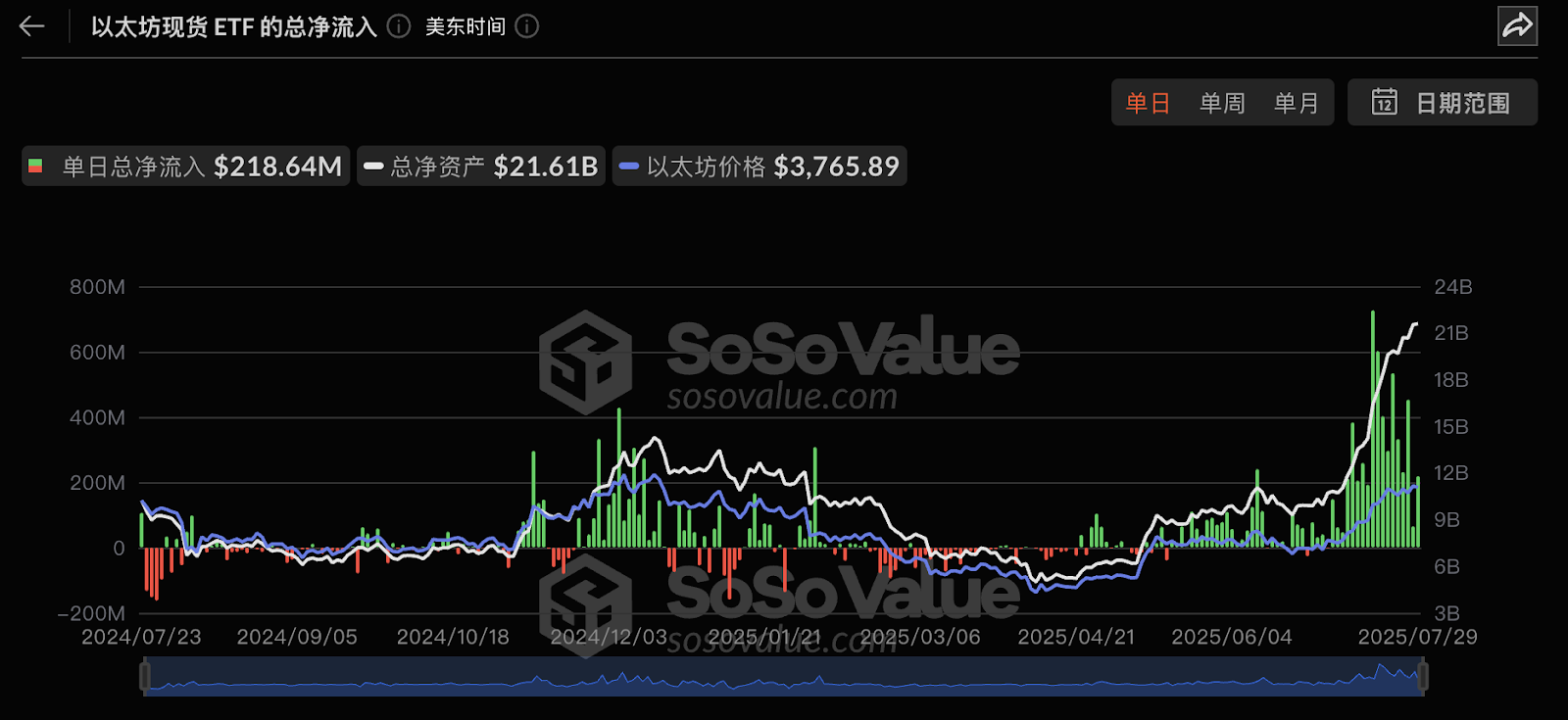
Source: SoSoValue
Looking ahead, in addition to spot ETFs, Ethereum staking yield ETFs are also on the horizon. On July 17, BlackRock's iShares Ethereum Trust (ETHA) officially submitted a 19b-4 filing with the SEC, proposing to introduce staking functionality to its Ethereum ETF. Analysts predict that the US is expected to approve the first ETH-staking ETFs in the second half of 2025. These products will offer an annualized staking yield of 3-5% on top of holding spot Ethereum, making them more attractive to institutions.
The most direct impact of the ETF effect on Ethereum is increased liquidity and demand. After institutions have invested in BTC ETFs, ETH ETFs have become the only option. With ETFs, large funds worth tens of billions of dollars can easily allocate assets, which undoubtedly significantly enhances ETH's investment properties and market depth, and is one of the key external factors supporting long-term bullishness.
III. Ethereum Foundation
The current surge in Ethereum's performance is also closely related to changes in the management team.
The Ethereum Foundation underwent a management restructuring over the past year. In March 2025, Hsiao-Wei Wang and Tomasz Stańczak were appointed as Co-Executive Directors of the Foundation. This dual-director model will decentralize decision-making power, reduce single-point dependency, and introduce more professional management alongside technical leaders like Vitalik to drive efficiency improvements. This model will preserve the community-driven open source spirit while strengthening external communication and strategic execution, promoting positive interaction between Ethereum and institutions and regulators.
Furthermore, Danny Ryan, a former core researcher at the Ethereum Foundation, has joined the Etherealize project, founded by former banker Vivek Raman. The project aims to introduce ETH into the mainstream financial system on Wall Street through education and market promotion for traditional institutions. This marks the first time the Ethereum core team has actively integrated into the traditional financial ecosystem. This will shift ETH's valuation logic towards institutionalization, significantly strengthening its long-term price support.
IV. K-line Technical Indicators
Ethereum has recently experienced a strong upward trend. Over the past month, ETH's price has surged approximately 60% from approximately $2,400, approaching $4,000 in late July. This increase far exceeds the broader market average, reflecting the market's optimistic outlook for Ethereum.
Technical indicators indicate that the ETH/BTC pair ended its prolonged period of sideways trading over the past three months and broke through a key range in mid-July, posting a 40% monthly gain. This suggests that capital appetite, previously dominated by Bitcoin, is shifting towards Ethereum, and that market appetite for risky assets is recovering.
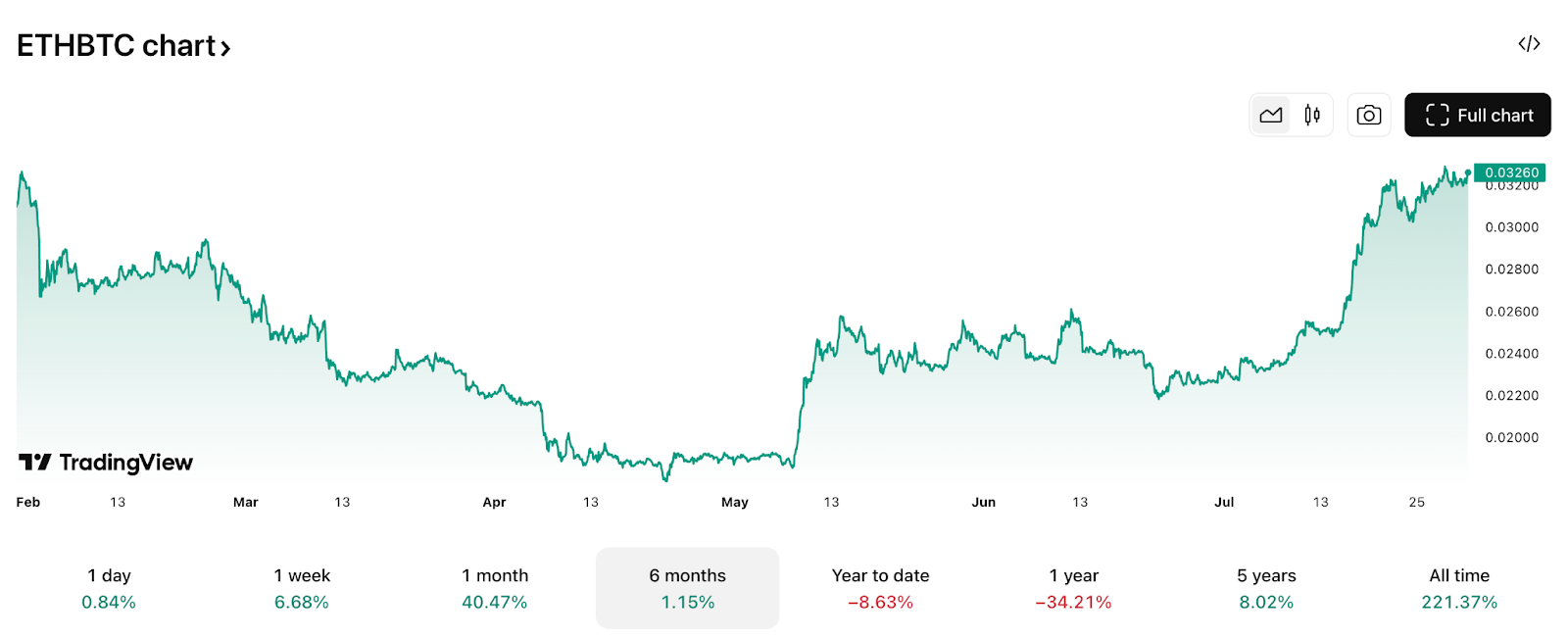
Source: TradingView
Furthermore, ETH's RSI (Relative Strength Index) fell back to around 30 on its weekly candlestick chart in April, historically considered a "buy low" zone. Data shows that whenever the RSI reaches this range (30-40), ETH often experiences a significant rally. For example, the last time this signal appeared in 2023-2024, ETH saw an increase of over 290%.
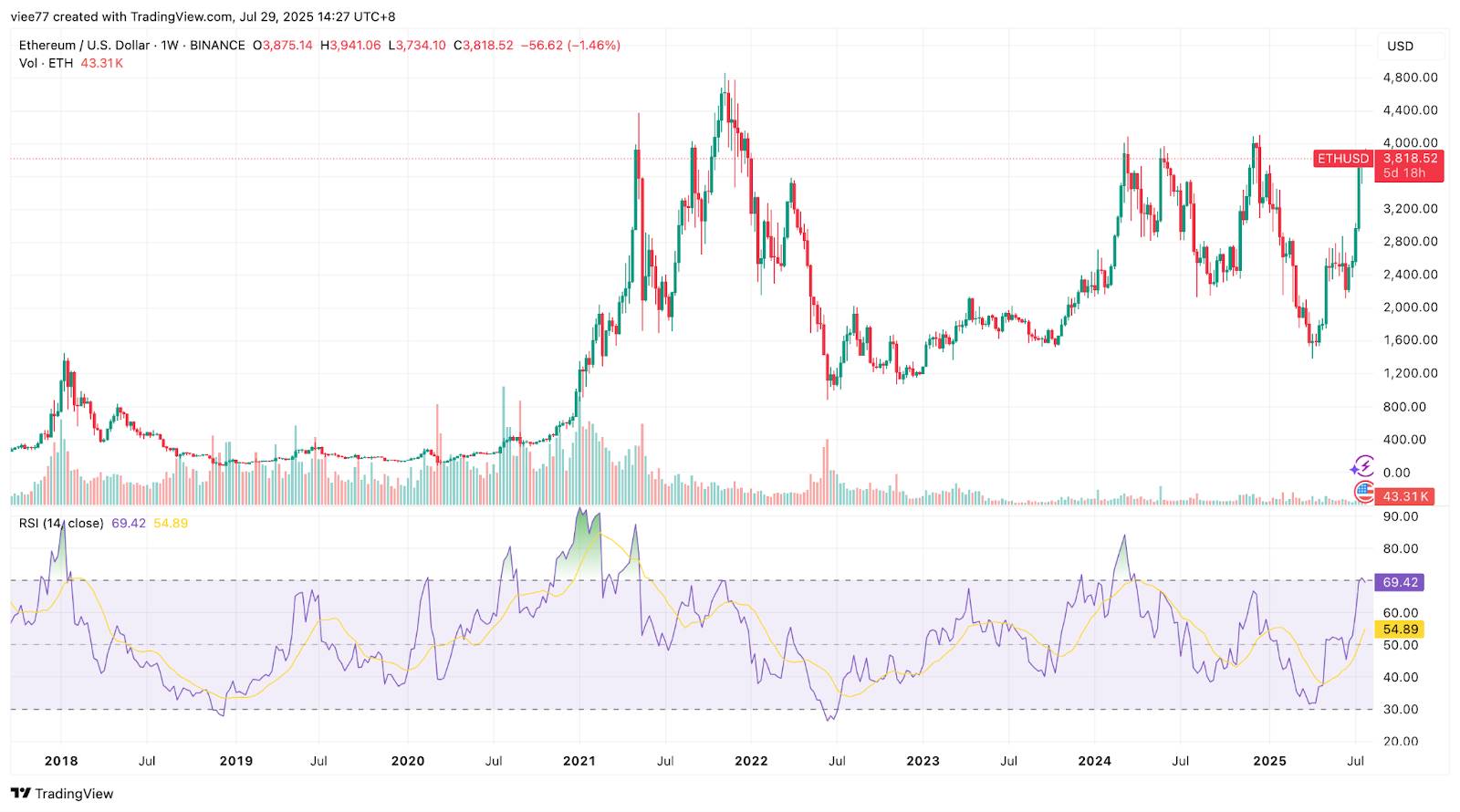
Source: TradingView
Analyst @MikybullCrypto first signaled this buy signal in April, calling it an "extremely rare buying opportunity that cannot be ignored" and predicting that ETH would double in value. He recently reiterated this view, suggesting that if the RSI continues to climb to higher levels, ETH's price could potentially reach the $7,000 to $10,000 range.
This means that, from a technical perspective, Ethereum's current rally may not be over yet.
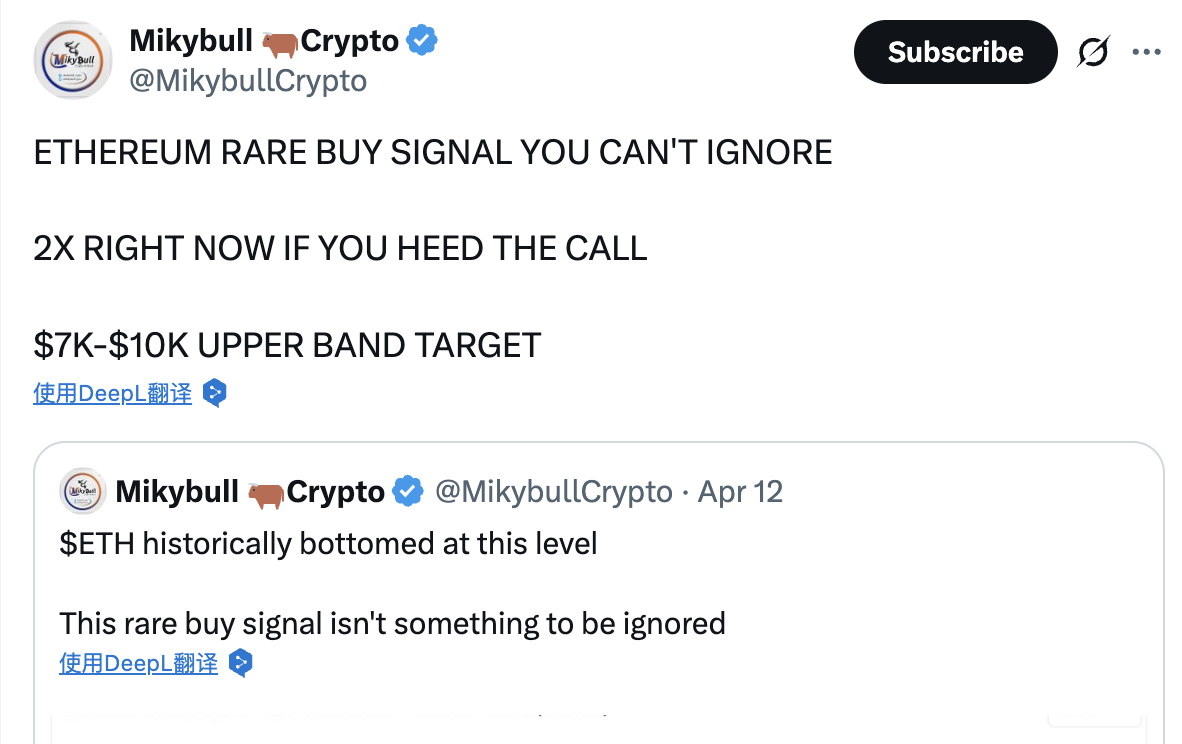
https://x.com/MikybullCrypto/status/1945580696140919266
V. On-Chain Indicators
On-chain data indicates a significant increase in Ethereum activity.
Transaction Activity: The average daily transaction count on the Ethereum mainnet has remained stable in recent months. In June 2025, the total monthly transaction count for Ethereum reached approximately 42 million (approximately 1.4 million daily), roughly the same as in previous months. It's worth noting that while on-chain gas fees are currently low, this likely isn't due to a decrease in users, but rather to a decrease in unit transaction costs due to increased network processing capacity following the mainnet upgrade. According to Nansen data, over the past month, the number of active Ethereum addresses increased by 16.3% over the past 30 days, and the number of transactions increased by 14.2% over the past 30 days. On July 22nd, the average daily transaction count reached 1.62 million, a six-month high. This high on-chain activity indicates that more users and applications are utilizing the Ethereum network.
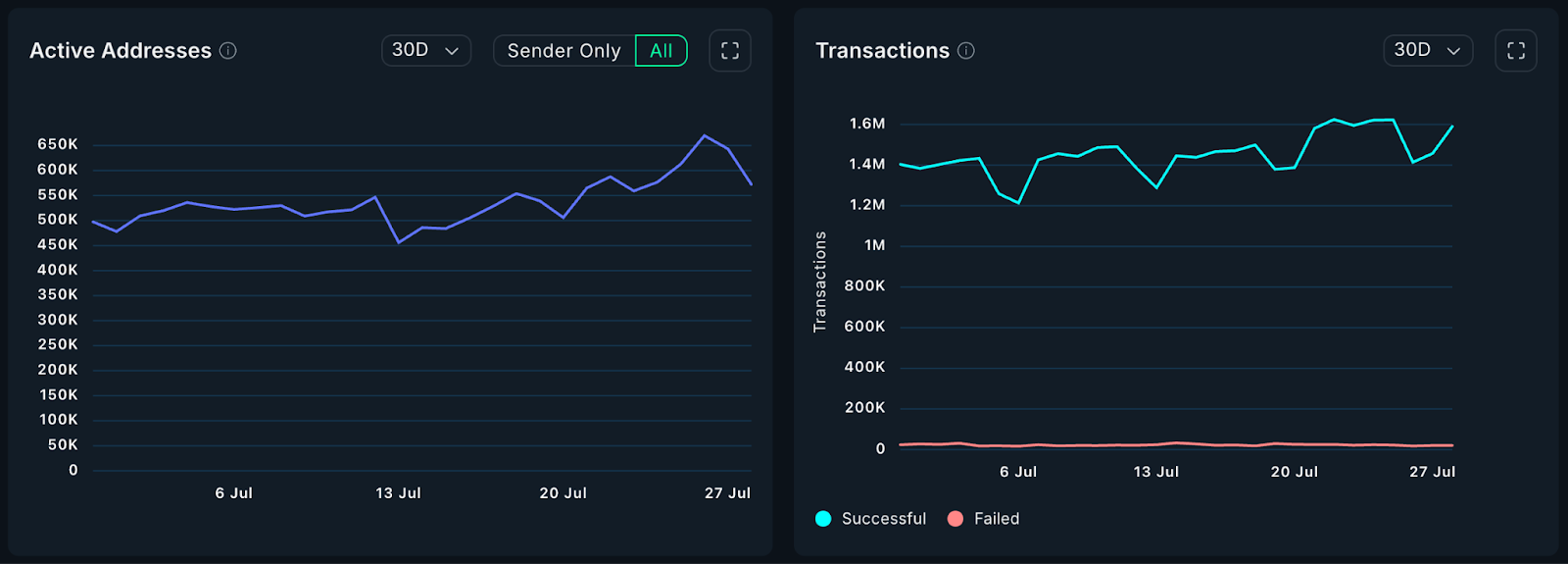
Source: Nansen
On-Chain Fees: With the recent recovery in coin prices and on-chain activity, Ethereum's fee revenue has also rebounded, surpassing other public chains again and returning to second place in on-chain fee revenue in the second quarter of 2025. According to Artemis data, Ethereum's total network fee revenue in June was approximately $39.1 million, second only to Tron, which to some extent reflects the return of demand for the Ethereum network.
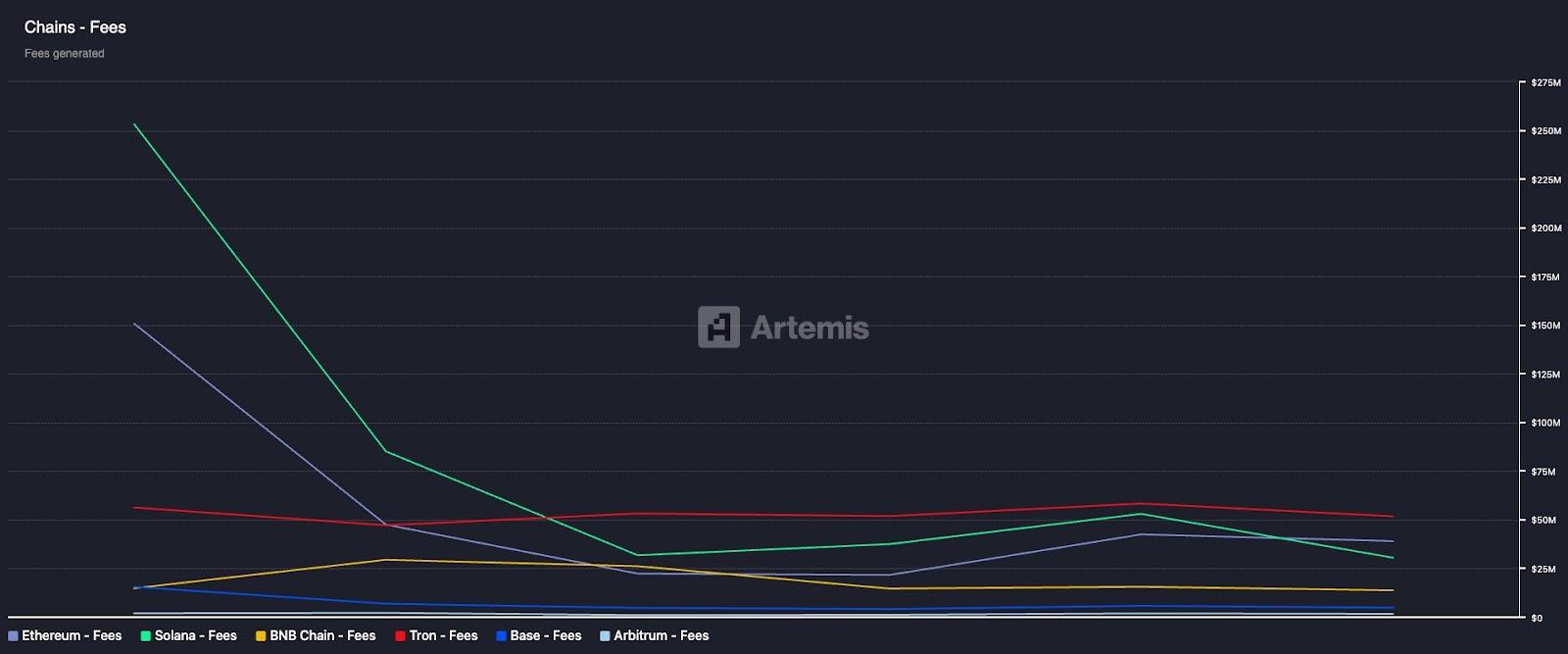
Source: Artemis
DeFi Total Value Locked (TVL): The DefiLlama data below shows that Ethereum's TVL rose from $60.2 billion on June 28 to a three-year high of $85.9 billion on July 28, a monthly increase of over 42%. Furthermore, the total TVL of DeFi across the entire network exceeded $153 billion in late July, a three-year high, with nearly 60% of that value locked in Ethereum. However, it's worth noting that Ethereum's price increased by 59.9% during the same period, exceeding the TVL growth rate. Furthermore, if TVL growth is measured in ETH terms, it has declined by 1%, indicating that the recent record high in TVL was primarily driven by the price of ETH. This means that if asset prices subsequently correct, the TVL indicator may also decline accordingly.
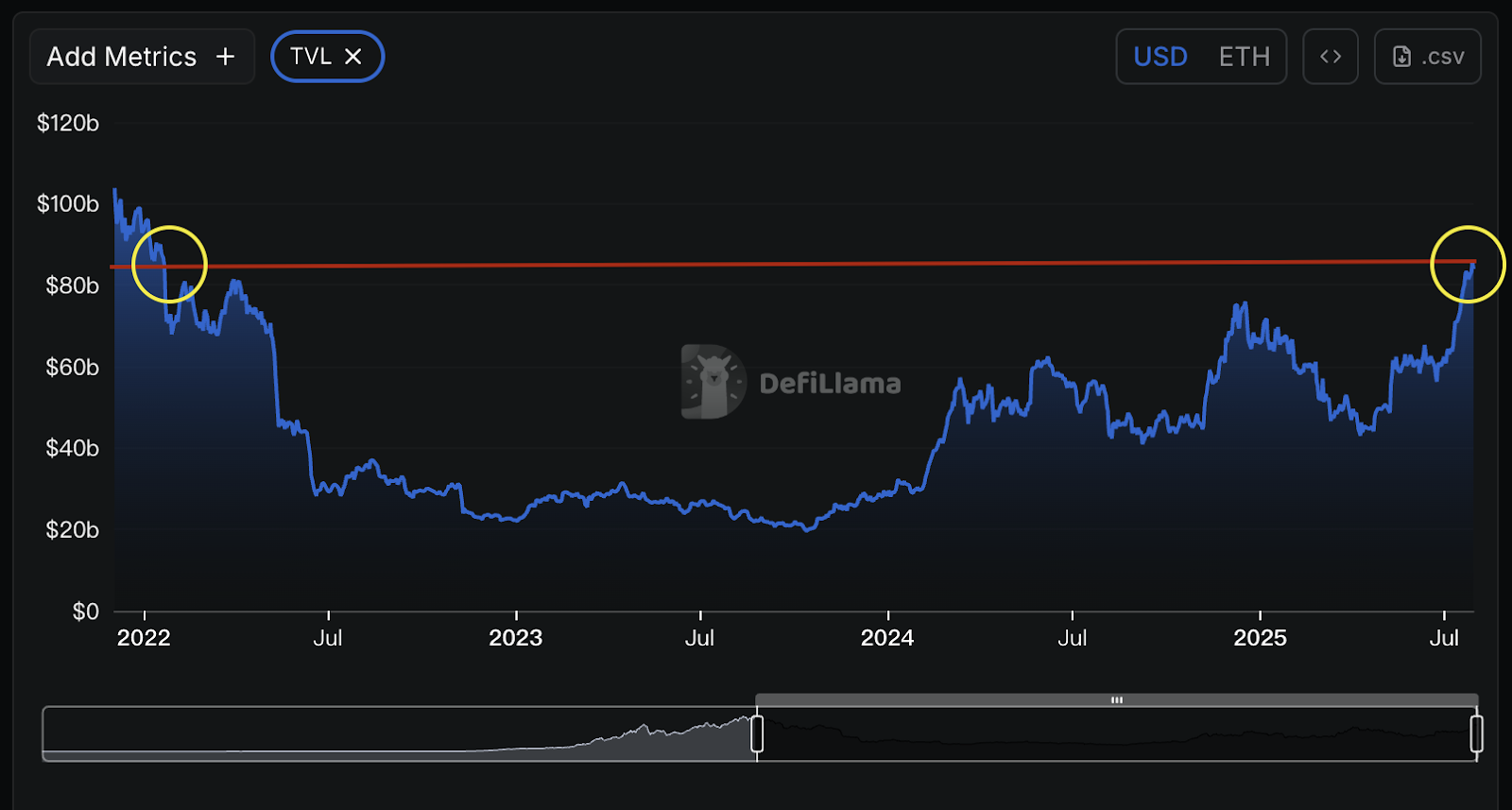
Source: Deflama (above: ETH TVL)
Staking Status: It's worth noting that Ethereum's staking has reached new highs—currently over 36 million ETH is staked, nearly 30% of the total supply. This locked-up ETH effectively reduces circulating supply, alleviating selling pressure from both a supply and demand perspective. While over 500,000 ETH have recently been queued for unstacking, the significant influx of new staking has offset the impact of significant withdrawals, ensuring the price remains strong. There's no need to panic.
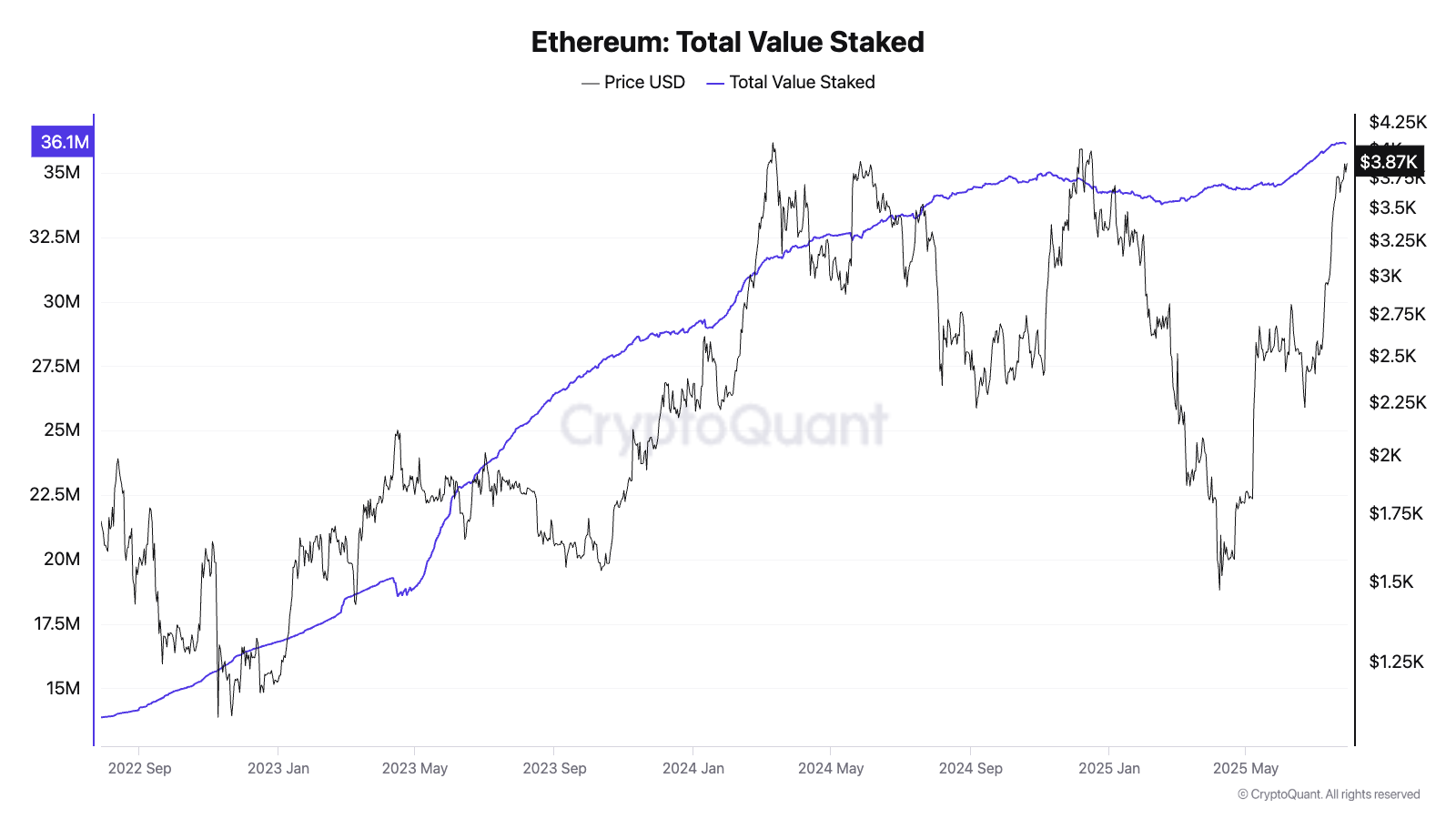
Source: Cryptoquant
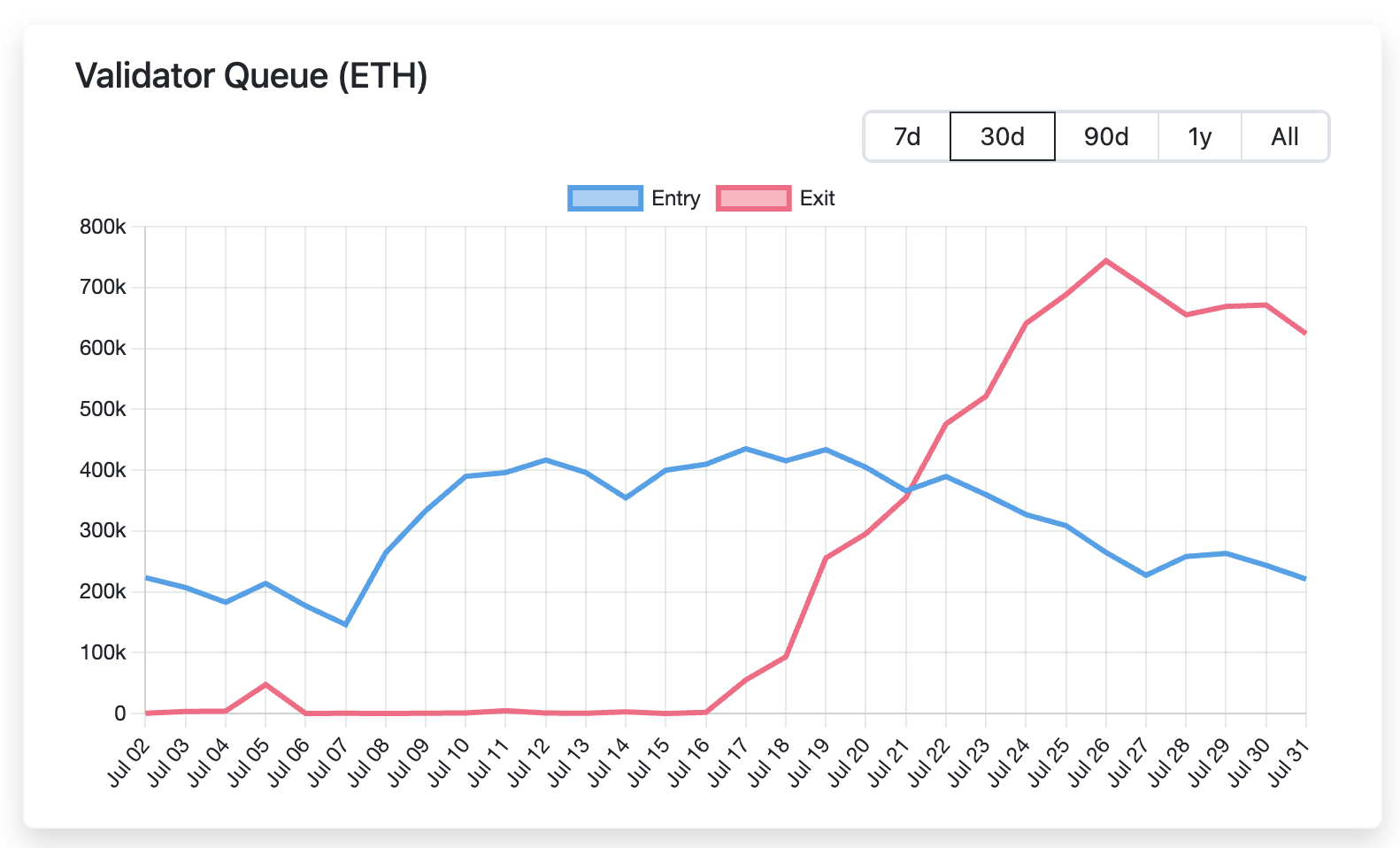
Source: validatorqueue
ETH Inflation: It's worth noting that the Ethereum network is currently experiencing mild inflation, with the actual inflation rate far lower than generally perceived by the market. According to statistics, over the three years since the merger, Ethereum's average annual net inflation rate (+0.117%) has been over 11 times lower than Bitcoin's inflation rate (+1.338%). The logic behind ETH is that the more it's used, the more it's destroyed, creating a positive cycle for network activity. This means that the traditional view of "ETH's unlimited inflation" is no longer valid. Over the past few years, ETH has experienced substantially low inflation, which may be a key factor supporting its upward trajectory.
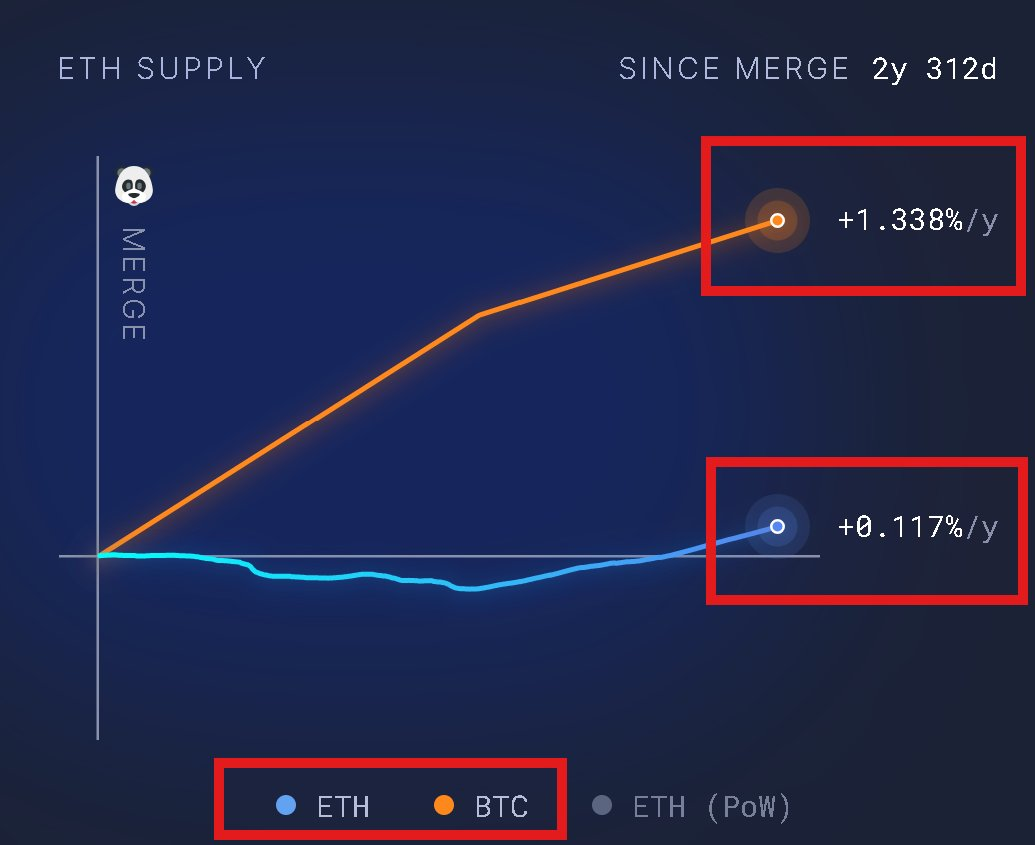
Source: ultrasound.money, @LeonWaidmann
Rising transaction volume, recovering transaction fees, staking lock-up, and low inflation—multiple on-chain indicators confirm Ethereum's positive fundamentals, providing strong support for continued price appreciation.
VI. RWA and the Stablecoin Narrative
A thorough analysis of the key metrics of major RWA-supporting on-chain networks (see the table below) reveals Ethereum's dominant position in the RWA and stablecoin markets.
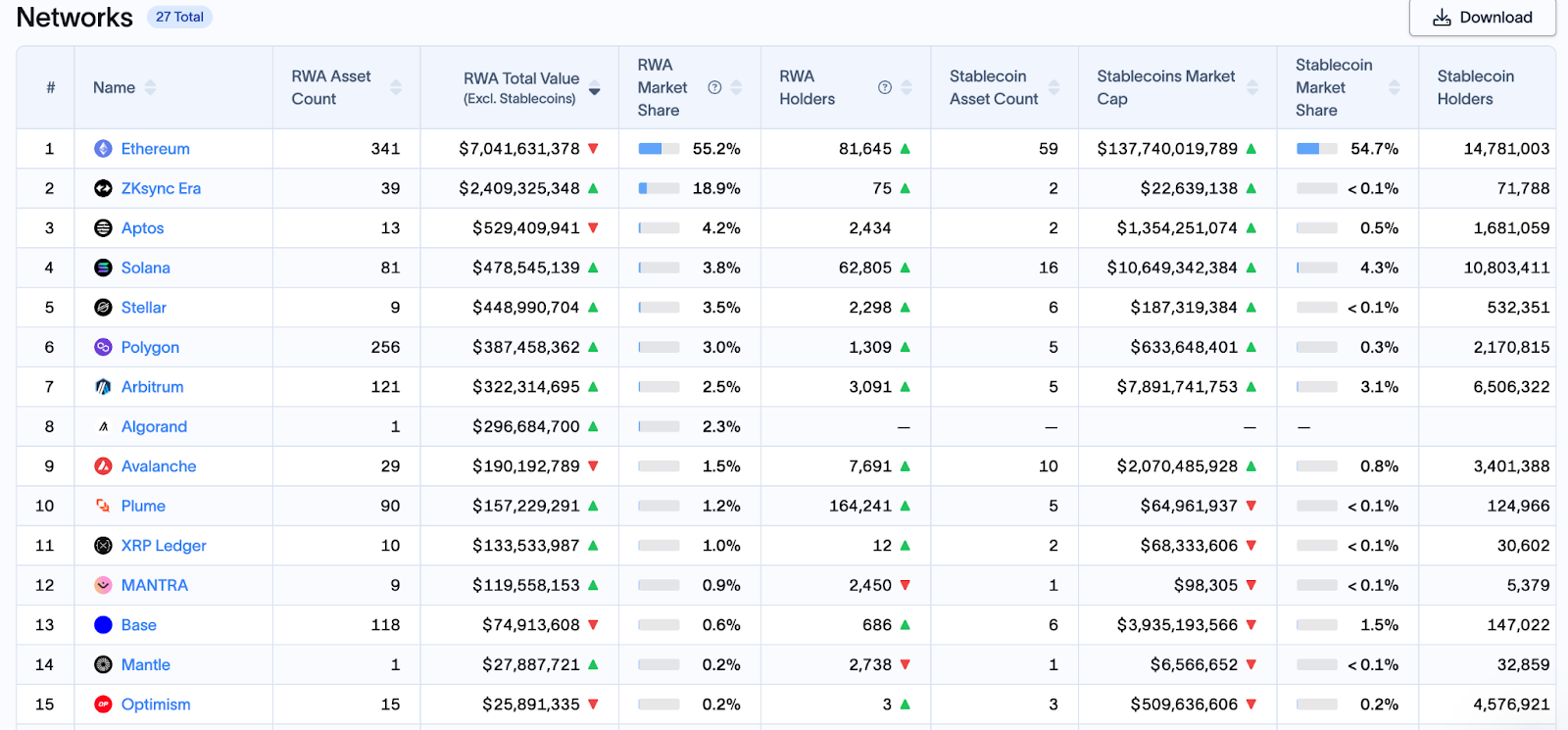
Source: RWA.xyz
RWA on the Chain: 2025 is being hailed by many industry insiders as the "Year of RWA," with a significant amount of real-world assets being tokenized through the Ethereum ecosystem. According to RWA.xyz, as of July 29, 2025, over 341 RWA assets were hosted on Ethereum, encompassing government bonds, real estate equity, and private equity. Their market capitalization reached $7 billion, representing approximately 55.2% of the entire on-chain RWA market, ranking first among all blockchains and approximately three times that of the second-place ZKsync. For example, BlackRock's tokenized fund, BUIDL, has surpassed $2.4 billion, with over 90% of its assets still hosted on Ethereum. As the RWA tokenization market continues to expand, Ethereum is poised to capture the lion's share.
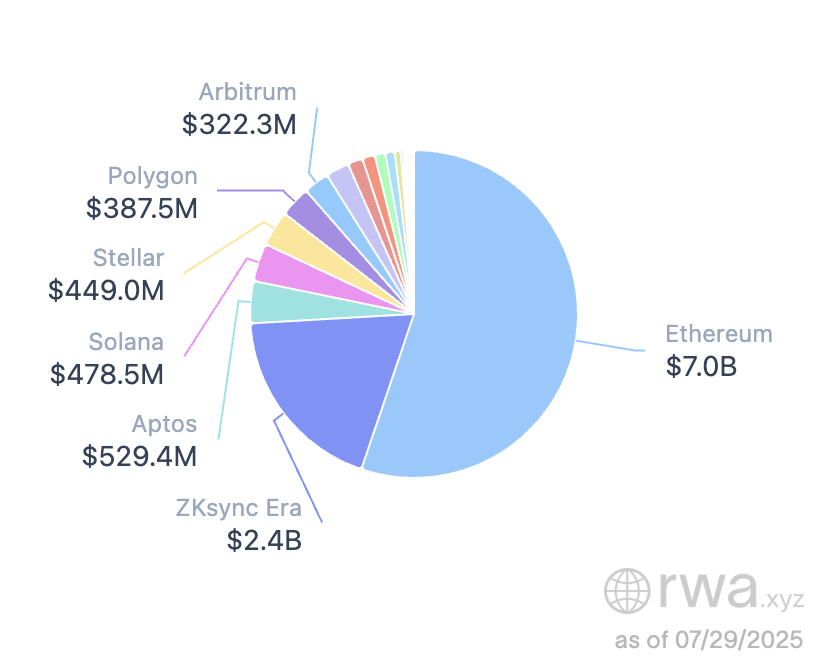
Source: RWA.xyz
Stablecoin Trends: Ethereum continued to solidify its position as an on-chain dollar carrier in 2025. As of July 29, 2025, the total stablecoin supply running on Ethereum accounted for over 54% of the total market, firmly ranking first among all public chains. Of the approximately $250 billion in total, over $137.7 billion in stablecoins (such as USDT and USDC) were circulating on the Ethereum network.
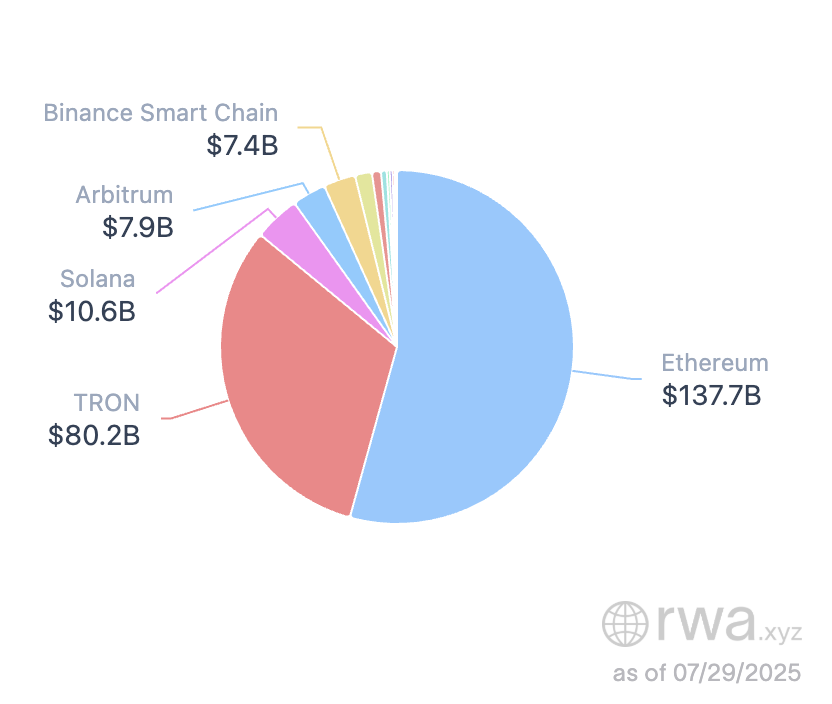
Source: RWA.xyz
It's important to emphasize that ETH was once viewed more as a crypto asset "superior to Bitcoin." However, with the accumulation of stablecoins and RWA, ETH now has a broader value proposition. On the one hand, ETH is indispensable as the "digital crude oil" for gas payments. Every stablecoin transfer and every RWA issuance consumes a small amount of ETH. On the other hand, ETH's "productive asset" attributes are becoming increasingly prominent. Staking ETH can generate native returns, similar to the interest earned on US Treasury bonds, which aligns with traditional capital's preference for yielding reserve assets. During a period of interest rate cuts, ETH's staking yield could exceed Treasury yields, and with significant upside potential, this makes ETH extremely attractive. Thomas Lee has publicly stated that Ethereum has unlimited potential as a stablecoin and RWA platform, making it Wall Street's top choice for compliant blockchain investments. Lee believes that the Ethereum network is severely undervalued, with its "fair value" ranging from $10,000 to $15,000, and the potential for over tenfold appreciation in the coming years.
In summary, the rise of stablecoins and RWAs is redefining ETH's investment value and creating the opportunity for Ethereum to become a global digital dollar clearing network. This is one of the key reasons why institutional investors have recently invested heavily in ETH.
VII. Ethereum Technology Roadmap
Ethereum has undergone continuous iterations and upgrades over the past decade, and the progress of its technical roadmap is a key internal driver of ETH's bullish outlook.
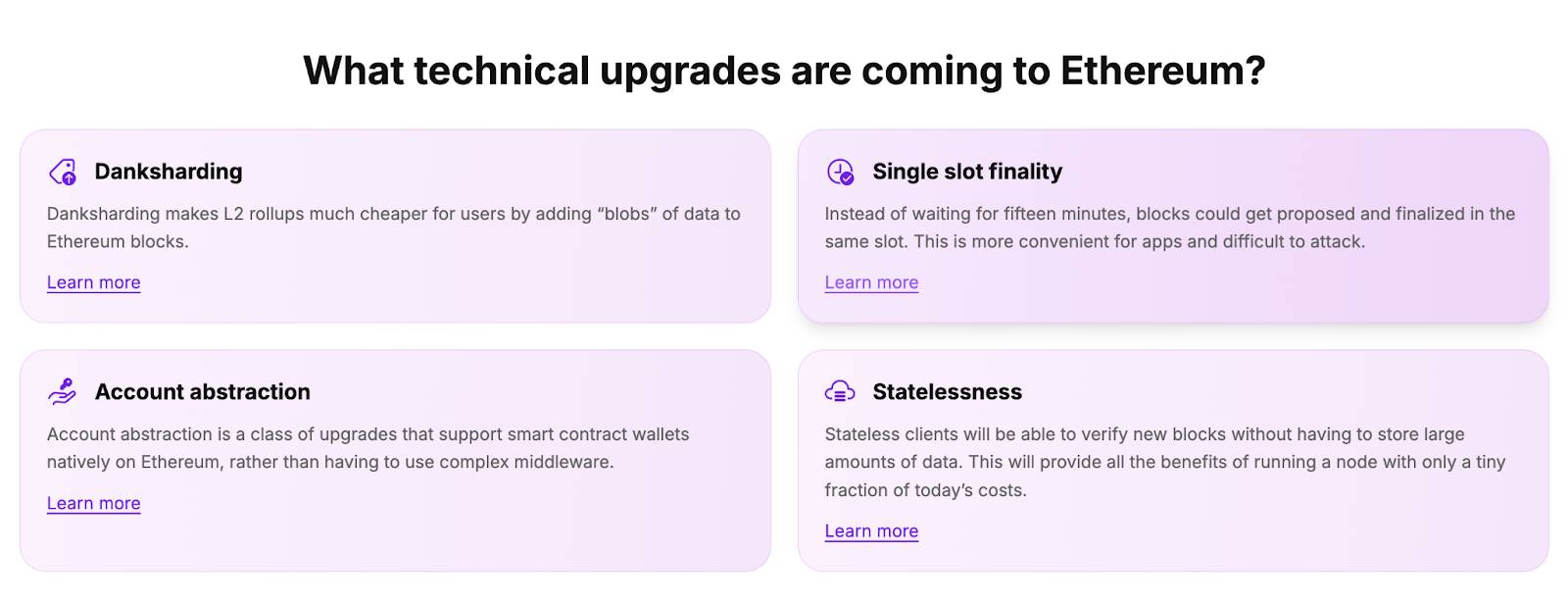
The most recent major upgrade, Pectra, was successfully implemented on May 7, 2025. It integrates the Prague and Electra sub-proposals, covering changes to both the execution and consensus layers. It introduces account abstraction (EIP-7702), an increase in the validator staking limit (to 2048 ETH), data expansion (increased blobs), a more flexible exit mechanism, and BLS precompiles, aiming to improve scalability and user experience, paving the way for subsequent sharding and Verkle trees. It is a key step in Ethereum's medium- to long-term roadmap. The next phase, the Fusaka upgrade, expected to launch around the end of 2025, will increase the number of data blobs per block by eightfold and introduce PeerDAS technology to improve on-chain data availability. Overall, the Ethereum development roadmap progressed as planned over the past quarter, including Proto-Danksharding, deepening account abstraction, data expansion, and validator mechanism reforms, continuously enhancing Ethereum's performance. Looking ahead, Ethereum will strive to complete full Danksharding sharding, achieve statelessness, and refine various modularization aspects. These performance improvements will lay a solid foundation for ETH's long-term value.
Summary
In summary, as Ethereum celebrates its tenth anniversary, we can see a convergence of internal fundamentals and external factors: positive core indicators, continuous technological upgrades, and optimized team governance have strengthened the Ethereum network. Furthermore, the emerging narrative of stablecoins and RWAs, as well as the incremental capital generated by ETFs, have injected a steady stream of upward momentum into ETH. Consequently, a growing number of asset management institutions and analysts are optimistic about Ethereum's medium- and long-term prospects, believing it has the potential to reach new heights in the coming years.
Of course, challenges from other public chains and regulatory changes may still cause volatility. However, what is certain is that at the start of the next decade, Ethereum is transforming into a "new financial infrastructure," and the excitement may just be beginning.







